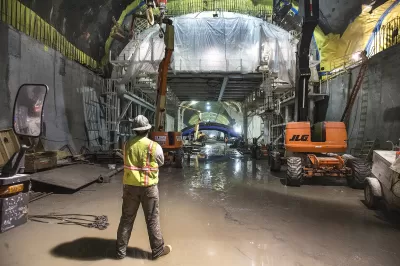One of the suggestions in Mayor Bill de Blasio's OneNYC citywide plan is nothing new: an oft-proposed subway extension down Utica Avenue in Brooklyn. Some question whether the area's relatively low density warrants such an expense.

Nowhere in the country is transit ridership growing quicker than in the American subway's original home. "Between 2009 and 2014—just five years—the New York Subway system's ridership increased by 384 million annual rides, far more than any other U.S. rail system carries in total."
So far, the city has found it difficult to fund the service improvements that figure demands. Mayor de Blasio's recently-released city plan suggests sweeping changes to the system, notably including two Second Avenue Subway extension phases.
Another suggestion has garnered attention: "Most dramatically, OneNYC recommends that the MTA study the extension of the Subway south along Utica Avenue through East Flatbush and Flatlands, a roughly four-mile route that would, if built, include the first new Subway stations outside Manhattan since 1989 and the first in Brooklyn since 1956."
However, the article observes that a full subway investment beneath Utica may be overkill: population density around the proposed Utica line is significantly lower than in the areas surrounding other proposed paths. An alternative exists: light rail. "Missing from the discussion is any intermediary between buses and Subways—it's as if the vocabulary of high-capacity surface rail has been excised from the minds of transportation planners in New York City."
It is important to note that the Utica line, if built, would predominantly serve poorer minority communities. Any discussion of its pros and cons should keep that fact in mind.
FULL STORY: Utica Avenue, OneNYC, and New York’s growth

Alabama: Trump Terminates Settlements for Black Communities Harmed By Raw Sewage
Trump deemed the landmark civil rights agreement “illegal DEI and environmental justice policy.”

Planetizen Federal Action Tracker
A weekly monitor of how Trump’s orders and actions are impacting planners and planning in America.

Why Should We Subsidize Public Transportation?
Many public transit agencies face financial stress due to rising costs, declining fare revenue, and declining subsidies. Transit advocates must provide a strong business case for increasing public transit funding.

Understanding Road Diets
An explainer from Momentum highlights the advantages of reducing vehicle lanes in favor of more bike, transit, and pedestrian infrastructure.

New California Law Regulates Warehouse Pollution
A new law tightens building and emissions regulations for large distribution warehouses to mitigate air pollution and traffic in surrounding communities.

Phoenix Announces Opening Date for Light Rail Extension
The South Central extension will connect South Phoenix to downtown and other major hubs starting on June 7.
Urban Design for Planners 1: Software Tools
This six-course series explores essential urban design concepts using open source software and equips planners with the tools they need to participate fully in the urban design process.
Planning for Universal Design
Learn the tools for implementing Universal Design in planning regulations.
Caltrans
Smith Gee Studio
Institute for Housing and Urban Development Studies (IHS)
City of Grandview
Harvard GSD Executive Education
Toledo-Lucas County Plan Commissions
Salt Lake City
NYU Wagner Graduate School of Public Service





























